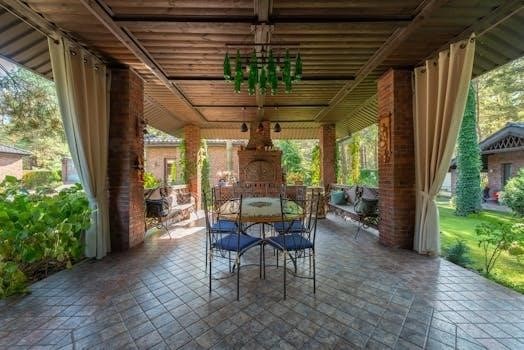Patio Cover Plans PDF⁚ An Overview
Patio cover plans in PDF format are readily available, offering a convenient way to access building guides. These downloadable plans often include various designs, ranging from simple lean-tos to more complex structures. Many free options exist for DIY enthusiasts.
Free DIY Patio Cover Plans
Numerous free DIY patio cover plans are accessible online, catering to various skill levels and design preferences; These plans often include step-by-step instructions, material lists, and detailed diagrams, making them suitable for those looking to build their own patio cover without incurring high costs. Some plans feature simple lean-to designs, while others offer more elaborate freestanding structures. Many designs incorporate common materials like wood, and some may include metal roofing options. Remember to check local building codes before commencing construction.

Attached Patio Cover Designs
Attached patio cover designs are a popular choice for homeowners, seamlessly extending living spaces. These covers are connected to the house, offering shade and protection. Many designs are available in various sizes and styles.
12 x 16 Attached Patio Cover
A 12×16 attached patio cover is a popular size, offering a substantial shaded area for outdoor gatherings. These plans often detail how to securely connect the cover to an existing structure, ensuring stability and longevity. The design provides ample space for furniture and activities, enhancing the usability of the patio. Such covers are often built with strong materials, and may include decorative hardware for a more customized look. Free plans are frequently available, making this a great DIY project.
Freestanding Patio Cover Options
Freestanding patio covers offer flexibility in placement, independent of existing structures. These designs vary greatly, from simple pergolas to more robust, fully covered structures. They are an excellent choice for adding shade anywhere in your yard.
Building a Free-Standing Patio Cover
Constructing a free-standing patio cover typically involves setting posts into the ground using concrete or galvanized post anchors attached to a slab. The frame is built with beams and rafters, often using wood like cedar or pressure-treated pine. Roofing materials range from metal panels to tin, chosen for durability and aesthetics. DIY kits offer a simplified approach, while custom designs provide flexibility. Consider local codes and material choices for long-lasting results. Proper sealing and maintenance of wood is essential.
Material Choices for Patio Covers
Common materials include wood, like cedar and treated pine, and metal, such as aluminum or steel. Each offers varying durability, cost, and aesthetic qualities, impacting the patio cover’s lifespan and appearance.
Wood vs. Other Materials
When choosing materials for patio covers, wood, particularly cedar and pressure-treated pine, presents a classic aesthetic. However, it requires regular maintenance to prevent rot, warping, and splitting. Metal options like aluminum and steel offer greater durability and reduced upkeep, but may not provide the same natural look. The decision hinges on balancing desired aesthetics, long-term maintenance requirements, and budget considerations. Wood can last for 20 to 30 years if sealed and stained properly, while pressure treated pine might last for 10 to 15 years.

DIY Patio Cover Construction
DIY patio cover construction is an achievable project, with readily available kits and free plans. These resources often include step-by-step instructions, making the process manageable for most homeowners.
Step-by-Step Building Guides
Detailed step-by-step building guides are crucial for successful DIY patio cover construction. These guides typically include material lists, cutting diagrams, and assembly instructions. Many resources offer free plans with clear, concise directions, making it easier for homeowners to undertake the project. Look for guides that provide information on different roof styles, such as flat, pitched, and shed roofs. These resources assist in proper post placement, beam installation, and rafter attachment. Following a well-structured guide is essential to ensure a structurally sound and aesthetically pleasing patio cover. Always check local codes.
Specific Patio Cover Dimensions
Common dimensions for patio covers include 10×20 and 12×12, catering to various patio sizes. Plans often provide flexibility to adjust dimensions while adhering to local codes.
10×20 and 12×12 Patio Cover Plans
Plans for 10×20 and 12×12 patio covers are popular choices, offering different coverage areas. The 10×20 option is suitable for longer, narrower patios, while the 12×12 provides a more square coverage area. These plans often detail material lists, and step-by-step building instructions. It’s essential to select a size that fits your space and needs. Always consider local building codes for proper installation. Adaptable plans allow for slight adjustments to match your specific requirements, ensuring a custom fit.
Roofing Options for Patio Covers
Various roofing options exist for patio covers, including pitched, flat, and tin roofs. Each type offers different aesthetics and functionality. The choice depends on your budget and desired style.
Types of Roofs⁚ Pitched, Flat, Tin
When selecting a roof for your patio cover, consider the various options available. Pitched roofs offer excellent water runoff and a traditional aesthetic, often seen with a 1.5⁚12 or 2⁚12 slope. Flat roofs are simpler to construct and provide a modern look, though they require proper drainage considerations. Tin roofs, or metal roofs, are durable and low-maintenance, offering a sleek appearance and excellent protection from the elements. These options can be adapted to various styles and sizes based on local building codes and personal preferences to suit your needs.
Attaching Patio Covers to Structures
Attaching patio covers to existing structures requires careful planning. Consider methods of attachment to the building’s rafters or fascia, ensuring structural integrity. Post anchors are often used for slab connections.
Methods of Attachment to Existing Buildings
When attaching a patio cover to an existing building, several methods can be employed. One common approach involves securing the cover’s rafters directly to the building’s rafters, ensuring a strong and stable connection. Alternatively, the patio cover can be attached to the fascia board, although this method might require additional support depending on the fascia’s strength. Another technique utilizes ledger boards, which are securely fastened to the building’s wall, providing a base for the patio cover’s structure. Post anchors are often employed when connecting posts to concrete slabs for added stability. Careful consideration must be given to the structural integrity of the existing building and the chosen method.

Code Compliance for Patio Covers
It’s crucial to check local building codes before starting any patio cover project. These regulations specify requirements for beam and rafter spans, ensuring safety and structural integrity. Compliance is essential.
Local Building Codes and Regulations
Before initiating any patio cover construction, thoroughly research your local building codes and regulations. These codes dictate specific requirements for materials, dimensions, and attachment methods. Ignoring these can lead to costly rework and potential safety hazards. Ensure your chosen design adheres to local guidelines concerning beam spans, rafter spacing, and required permits. Many municipalities provide online resources or building departments where you can obtain detailed information about patio cover regulations. Compliance is not optional; it’s a mandatory step for a safe and legally sound project.

Cost Considerations for DIY Patio Covers
DIY patio covers offer significant cost savings compared to professional installations. Material costs and plan expenses are usually much lower, making it a budget-friendly option. Consider material choices to further reduce expenses.
Saving Money with DIY Projects
Building a patio cover yourself can lead to substantial savings, primarily by eliminating labor costs. Opting for DIY over professional installation allows you to control material expenses and choose more budget-friendly options. The initial cost might seem higher than a cheap cover, but DIY structures are often more durable and permanent. Furthermore, many free plans are available online, reducing the upfront expense of designing your patio cover. Investing time in DIY projects can result in a higher quality structure, at a much lower overall cost and you save thousands.
